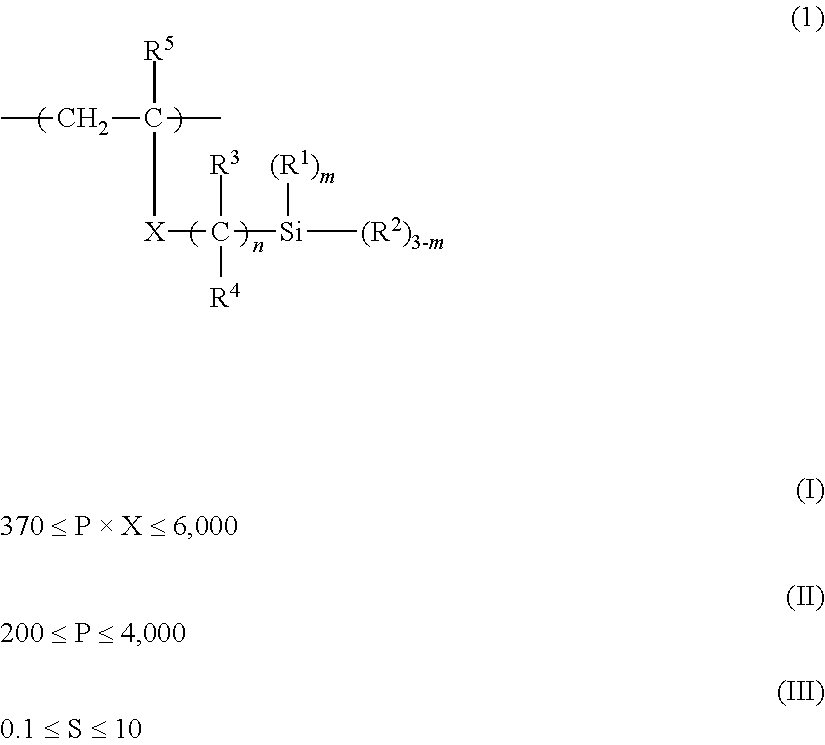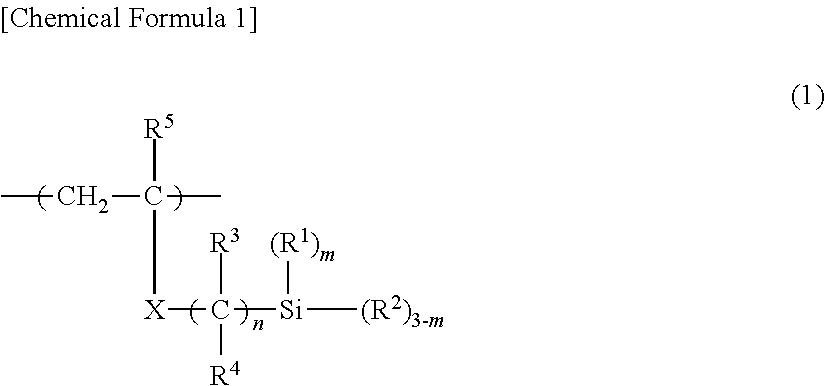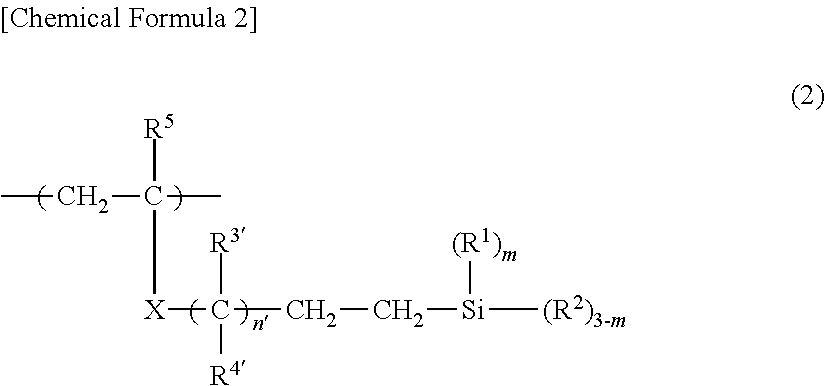Vinyl alcohol polymer, aqueous solution, coating agent, ink jet recording material, thermal recording material and base paper for release paper containing same
a technology of alcohol polymer and aqueous solution, which is applied in the field of alcohol polymer, can solve the problems of difficult to obtain coating film, and less likely to dissolve silyl group-containing pva, and achieves high viscosity stability, water-resistant and binder performance, and the effect of sufficient solubility in water
- Summary
- Abstract
- Description
- Claims
- Application Information
AI Technical Summary
Benefits of technology
Problems solved by technology
Method used
Image
Examples
example 1-1
Production of PVA1-1
[0233]Into a 6 L separable flask equipped with a stirrer, a reflux condenser, a nitrogen inlet tube, a comonomer dripping port and an addition port of the initiator were charged 1,500 g of vinyl acetate, 500 g of methanol and 1.87 g of MAmPTMS as the monomer having a group represented by the above formula (1) (monomer A), and replacement with nitrogen gas in the system was carried out for 30 min by nitrogen bubbling. Also, a comonomer solution was prepared as a delay solution by dissolving MAmPTMS in methanol to give a concentration of 8%, and subjected to replacement with nitrogen by bubbling of nitrogen gas. An elevation of the temperature of the reaction vessel was started, and 0.8 g of 2,2′-azobisisobutyronitrile (AIBN) was added to initiate the polymerization when an internal temperature of 60° C. was attained. The polymerization was allowed to proceed at 60° C. for 2.7 hours while adding the delay solution dropwise such that the monomer composition (proport...
examples 1-2 to 1-31
and Comparative Examples 1-1 to 1-22
Production of PVA1-2 to PVA1-53
[0236]PVA1-2 to PVA1-53 were produced in a similar manner to Example 1-1 except that: polymerization conditions such as the amount of vinyl acetate and methanol charged, and the type and amount of addition of the monomer A; and saponification conditions such as the concentration of PVAc and the molar ratio of sodium hydroxide to the vinyl acetate unit in saponification were changed as shown in Table 1 and Table 2. Results of analyses of each PVA obtained are shown in Table 1 and Table 2.
TABLE 1Polymerization conditionsmodifieramount ofconcentration ofinitiallysequentiallysequentiallyvinyladdedpolymerizationinitiallyadded liquidaddedacetatemethanolinitiatortimeadded amount(methanol liquid)amountType of PVA(g)(g)(g)(h)monomer A(g)*1(%)(g)Example 1-1PVA1-11,5005000.82.7MAmPTMS1.87899Example 1-2PVA1-21,5005000.82.7MAmPTMS0.93579Example 1-3PVA1-31,5005000.82.7MAmPTMS15.4950131Example 1-4PVA1-41,5005000.82.7MAmPTMS11.54012...
examples 1-32 to 1-66
and Comparative Examples 1-23 to 1-46
Preparation of Aqueous Solution
[0237]Using PVA1-1 to PVA1-53, aqueous PVA solutions were prepared so that the concentration and the pH as predetermined were attained. Viscosity stability of the aqueous PVA solution, water resistance of the coating film, water resistance of the coating film containing an inorganic substance, and binder force between the PVA and an inorganic substance were evaluated in accordance with the following evaluation methods. The type of the PVAs used and the pH of the aqueous solutions as well as the results of the evaluations are shown in Table 3.
[0238]Viscosity Stability of Aqueous PVA Solution
[0239]An 8% PVA aqueous solution was prepared and left to stand in a thermoregulated bath at 20° C., and a viscosity of the aqueous PVA solution immediately after the temperature of the aqueous PVA solution reached 20° C. and a viscosity of the aqueous PVA solution after 7 days were determined. A value obtained by dividing the vis...
PUM
| Property | Measurement | Unit |
|---|---|---|
| pH | aaaaa | aaaaa |
| viscosity | aaaaa | aaaaa |
| degree of polymerization | aaaaa | aaaaa |
Abstract
Description
Claims
Application Information
 Login to View More
Login to View More - R&D
- Intellectual Property
- Life Sciences
- Materials
- Tech Scout
- Unparalleled Data Quality
- Higher Quality Content
- 60% Fewer Hallucinations
Browse by: Latest US Patents, China's latest patents, Technical Efficacy Thesaurus, Application Domain, Technology Topic, Popular Technical Reports.
© 2025 PatSnap. All rights reserved.Legal|Privacy policy|Modern Slavery Act Transparency Statement|Sitemap|About US| Contact US: help@patsnap.com



